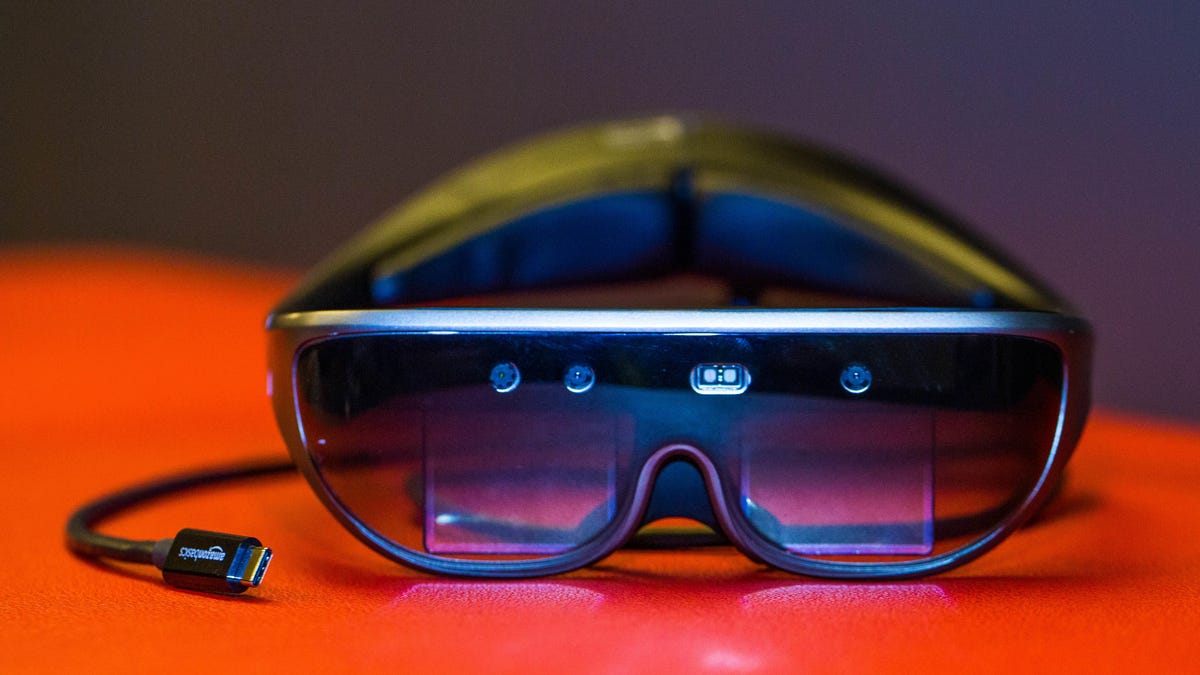Rokid Project Aurora USB-C smart glasses could be a wearable Nintendo Switch display
Expect a price close to a midrange smartphone.

Rokid's Project Aurora smartglasses are made to plug right into any USB-C powered device.
Mixed-reality headsets like the Magic Leap One and Microsoft HoloLens cost thousands of dollars. Even smart glasses like the Vuzix Blade cost around $1,000. At prices like that, it's hard to imagine augmented reality (AR) headsets ever taking off.
Rokid, a China-based AI company that launched a pair of somewhat glasses-like smart glasses at CES 2018 called the Rokid Glass, showed a prototype of its newest headset concept, Project Aurora, at this year's show. Unlike last year's standalone, expensive Glass, which only projected a display in one eye like the Google Glass or Vuzix Blade, the Project Aurora headset has two displays for 3D content, and connects to external devices via USB-C. The goal is a low-cost set of glasses that can connect to anything... even a Nintendo Switch.
The Aurora glasses fit over my own glasses, but it wasn't ideal.
The Aurora glasses I tried weren't in their final form, and can theoretically handle more advanced functions like full-motion 6DOF (6 degrees of freedom, or full motion) tracking and spatial navigation (SLAM). I still have questions.
The Nintendo Switch doesn't work with just any USB-C dongle, but Rokid's director of product, Reynold Wu, feels confident the company will be able to make it work. I didn't get to try the Aurora with a Switch, but I tried the glasses connected to an Android phone and played a few games and watched a few movies. The display was crisp and very bright, but in my demos it was more of a second screen than a way to project holographic effects into the real world like a HoloLens or Magic Leap One. It would depend on what apps could drive mixed reality... which right now, on a phone or tablet, is nearly none.
What Rokid's Aurora eyewear design is aiming for next. Very Vegas.
Rokid says the price will be around the same as for a midrange phone, and far less than the $1,000-plus that most smartglasses seem to land at.
A future final design aims to look even more like regular glasses (I wore that mockup, and felt like I was a cyberpunk/'70s nightclub owner). It would be wild to see the Aurora shrunk down to that form, but those shaded sunglasses weren't functional yet.
Internal speakers built into the prototype glasses I wore sounded decent, similar to the personal speakers in an Oculus Go or Magic Leap One. To control things, I just used the connected phone's touchscreen.
At what price would USB-C glasses with displays make sense? If these could get down to the price of headphones, maybe. Rokid aims to ship its standalone glasses, the Rokid Glass, this spring. The USB-C Aurora looks like something a bit further down the road.
Some basic specs, from the manufacturer:
- Weight: about 120g
- 3D stereo display, 45 degree FOV, binocular 1,280x720-pixel resolution, waveguide optics
- 13MP RGB camera
- 6DOF (6 degrees of freedom) depth-tracking camera
- IMU (Inertial Measuring Unit) with three-axis accelerometer, gyroscope, magnetometer
- SLAM (simultaneous localization and mapping)-capable
- 2 microphones
- Built-in stereo speakers
- Bluetooth 4.0, Wi-Fi
- USB-C port
Everything we learned at CES 2019: The executive summary for the entire show
VR needs more Disney-style magic like The Void from CES 2019: How to get VR right

